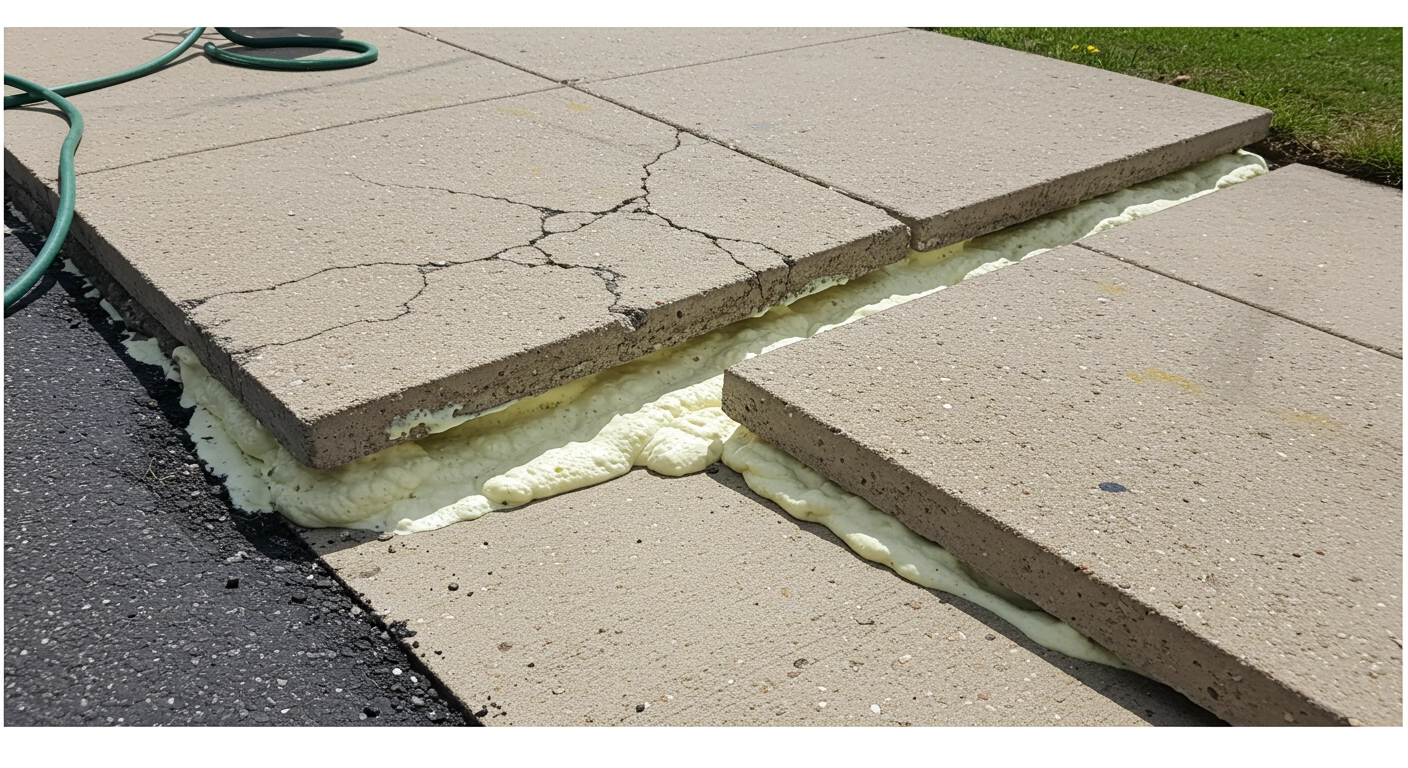If you’ve noticed uneven driveway slabs, that subtle slope might be more than just an eyesore. It could be a hazard to tires, to ankles, and to your home’s value. At R-Factor Spray Foam, we talk to homeowners every week who are frustrated by cracked concrete, water pooling in the wrong spots, and the creeping worry that these issues will just get worse. The good news? Concrete foam lifting can solve this, fast and cleanly.
This guide will walk you through what foam lifting actually is, how it compares to other options, and why it’s become the go-to method for repairing sunken concrete. By the end, you’ll know exactly how it works, what to expect, and why R-Factor Spray Foam is the team that can do it right.
How Concrete Foam Lifting Works to Fix Sinking Driveway Slabs
Sunken slabs happen when the soil beneath your driveway shifts, settles, or washes away. Foam lifting targets that gap beneath the surface filling it, stabilizing it, and raising your concrete back to its proper level with minimal disruption.
Polyurethane Foam: A Controlled Lift
We inject high-density polyurethane foam beneath the slab through small holes. As the foam expands, it gently lifts the concrete back into place. This isn’t guesswork we monitor the lift in real time to avoid overcorrection. Once cured, the foam forms a solid, waterproof base that resists future movement.
Long-Term Stability from a Clean Install
Foam lifting avoids the mess and delay of full replacement. There’s no need to demolish or pour new concrete. And because the foam is lightweight, it doesn’t add pressure to already unstable soil. That makes the solution stable over time, and incredibly durable something our clients appreciate after years of battling sunken spots.
When Foam Lifting is the Right Call
We get it: homeowners want to be sure they’re choosing the right fix, not a temporary patch. Concrete foam lifting is ideal for most residential driveways where the concrete is intact but no longer level.
Avoiding Full Replacement
If the surface is in one piece and there aren’t major cracks running through it, foam lifting gives you back your driveway without the downtime of a full pour. Even slabs that have sunk two or three inches can often be restored in a single visit.
Fixing More Than Just Uneven Concrete
Uneven slabs can lead to other issues water running toward your garage, drainage problems in flower beds, even tripping hazards for kids and visitors. Foam lifting addresses the root cause, restoring proper slope and surface without disturbing landscaping or nearby structures.
Why R-Factor Spray Foam Is the Right Partner
We’re not a franchise and we’re not a volume contractor. We specialize in spray foam and structural lifting, and we’ve built our name on precision, reliability, and honest assessments.
Small Teams, Big Results
Our crews are tight-knit and highly trained. That means we don’t just show up and pump foam. We take the time to understand why the concrete sank in the first place, and we approach every job with a plan to fix it for good.
Transparent Process, No Surprises
From the initial inspection to final cleanup, we walk you through what we see and what we recommend. If foam lifting isn’t the right solution, we’ll tell you and help you find the fix that is.
Comparing Foam Lifting to Mudjacking and Replacement
You might be wondering how foam lifting stacks up to other methods. Here’s a breakdown.
Foam Lifting vs. Mudjacking
Mudjacking uses a cement slurry to lift concrete. It’s heavier, requires larger holes, and often re-settles over time. Foam is lighter, sets faster, and typically lasts longer without movement.
Foam Lifting vs. Full Replacement
Replacing a slab can take days and comes with the cost of demolition, new materials, and curing time. Foam lifting usually takes a few hours, requires no tear-out, and allows you to use your driveway the same day.
How We Inspect Driveways for Foam Lifting Eligibility
Every job starts with a thorough site evaluation. We look at the surface condition, underlying soil, slope issues, and surrounding landscaping. It’s not just about lifting concrete—it’s about making sure the fix lasts.
Signs Your Driveway Is Ready for Foam Lifting
- Slabs are intact but visibly tilted
- No major crumbling or deep fractures
- Water runoff is misdirected
- Gaps between the slab and adjoining structures
When Foam Lifting Isn’t the Best Fit
If the concrete is extensively cracked or crumbling, replacement might be better. In those cases, we’ll still inspect and advise you on the right path forward.
Ready to Fix Your Driveway Without the Mess?
Sunken slabs don’t need to stay that way. At R-Factor Spray Foam, we help homeowners restore safety, function, and peace of mind without demolition or delays. Whether you’re seeing cracks, shifting, or just tired of a crooked slab that collects water every time it rains, we’re here to help.
Let’s get your driveway back in shape.
Call us at: (352) 663-5905
Email: [email protected]
Still Curious? Let’s Dive Deeper with R-Factor Spray Foam
- What causes driveway slabs to sink in the first place?
Soil erosion, poor compaction during construction, and moisture changes are the most common culprits. Foam lifting targets the empty space they leave behind. - How long does concrete foam lifting last?
When installed correctly, the results can last decades. The foam is stable, water-resistant, and immune to erosion. - Is foam lifting safe for driveways with vehicles?
Yes. Once cured, the foam can support vehicles of all sizes, including trucks and SUVs. - Will my driveway look the same after foam lifting?
Yes. The drill holes are small and we patch them to match the surrounding surface as closely as possible. - How long does the process take?
Most residential jobs are completed in a few hours. You can usually drive on it the same day. - Is this an environmentally friendly solution?
The foam we use is inert and doesn’t leach chemicals into the soil. It’s a clean fix with minimal environmental impact. - Does R-Factor Spray Foam handle other concrete issues?
We focus on foam lifting for structural leveling and spray foam insulation, but we can connect you with trusted partners if you need major concrete repairs. - What if my slab keeps sinking after lifting?
It’s rare, but if it happens, we investigate the underlying cause and re-evaluate the soil conditions. We stand by our work. - Can foam lifting be done in cold or wet conditions?
We work in a variety of weather conditions, but extreme cold or standing water may require rescheduling for best results. - What’s the cost compared to replacement?
Foam lifting typically costs less than half of what you’d pay to replace a slab, and there’s no extended downtime.


